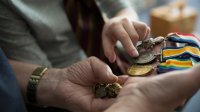Updating an Age-Old Class Activity
Personal artifact sharing—aka show-and-tell—is a way to build a healthy classroom environment. Even in high school.
Show-and-tell, as we know, is an age-old activity in elementary school classrooms. Kids bring in a pet, or a parent, or a certificate they won in dance class, or a trophy from peewee baseball. But why stop with the younger grades? What about older students? Sharing a meaningful memento with classmates is valuable at any age—and can serve several purposes.
The term “student artifact” refers to learning artifacts, things produced by the child during a unit of study like an essay, diagram, or poster project. Artifacts are an important component of learning and evidence of knowledge/skill transference from the conceptual to the tangible.
As teachers, let’s take on the challenge of expanding that definition and begin having students bring in meaningful artifacts from the outside world to share with their classmates (yes, middle and high school teachers, too).
The Benefits
Every classroom develops it own unique environment. As teachers, we hope for a healthy one, where students know each other’s names and interests, each other’s strengths and challenges. They should know each other’s triggers, and steer clear of them. There are many ways we can build that healthy, caring environment during the school year: community circles, small group work, and partner tasks, to name a few.
This sort of stuff is not included in academic standards, but is a critical part of our work as educators—building connections, a collaborative spirit, and community in the classroom. So let me continue my pitch for infusing show-and-tell as a routine in your classroom, regardless of your students’ ages.
When students bring in personal artifacts, they get to see what they have in common with each other. Sharing personal artifacts as a routine is a student-centered activity, but it also will assist the teacher in designing a culturally relevant curriculum. (“Culture” here refers to, but is not limited to, all of the following: race, ethnicity, age, interests, and family traditions.) We want to be responsive to the children we teach, bringing their lives—their interests, challenges, concerns, ideas, traditions, and histories—into the center of the curricula we design.
Examples
As students bring in and discuss artifacts from their lives, the teacher will spot topical or thematic patterns to inform her curriculum design:
- A student shares his grandpa’s military lapel pin from the Vietnam War. Other students then talk about family members in the military and how those relatives have affected their families. The social studies teacher then decides that the upcoming Cold War unit will begin with some readings on the generational effects of war.
- A student shares her quinceañera invitation, projecting a photo of it from her laptop. Several of her classmates announce that they too are currently planning quinceañeras. This inspires the language arts teacher to focus a narrative writing unit on the theme Rites of Passage.
The Logistics
Ask your students to email photos of artifacts that you can project, if they prefer this method or are unable to bring the artifacts in. Then create a slide show of the photos and call students up individually, in pairs, or in small groups to discuss their artifacts. Consider having thematic shares—something that changed your life, a artifact that represents your family or who you truly are, or an artifact that is celebratory, serious, or surprising.
For the sake of time (which we teachers know is always a looming concern), you can assign students to share in small groups, using a tablet screen to display images of the artifact.
Create wall space in the classroom where you can tack up photos of the personal artifacts, with a bulletin board title such as “Our Lives.”
It’s Innovative—Really
Making this exercise a routine instead of a one-off is worthwhile. When building that healthy environment, we have to consistently be sending the message to students that their lives and experiences outside of the classroom matter. So making a holistic activity such as this a routine in the classroom serves to humanize students. It gives a solid nod to de-institutionalizing the traditional classroom, which in itself is transformative and innovative.
